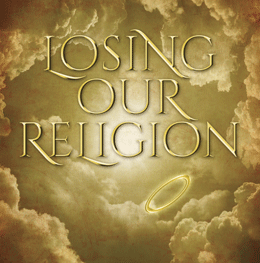
Recent studies have shown an increasing number of people growing further away from the brick-and-mortar worship setting, but that doesn’t necessarily mean it’s a matter of lost faith.
You’ve heard the phrase before: spiritual but not religious. It’s the mantra of the growing population that has drawn away from the traditional worship setting they were brought up around. There are different explanations for this cultural shift; it could be a matter of rebellion, time management, disinterest or distrust.
But if you ask local theologians and religious leaders, the statistics that come out don’t paint a true picture, and that includes recent numbers from the Pew Research Center suggesting as many as 44 percent of Americans have left their childhood faith, whether it’s for another sect or no religion at all. They believe it’s more of a case of people leaving in favor of finding faith on their own. They check that non-committal “unaffiliated” box rather than identify with what they know from the past—the priest or rabbi in the pulpit and the one-way preaching. Stand, sit, kneel, recite and repeat.
Some translate this into a growing number of non-believers. Christian and Protestant affiliations dropped by five percent across the nation between 2007 and 2012, according to Pew, and the unaffiliated amount rose by 4.3 percent to a substantial 19.6. However, the increase among atheists and agnostics stood at just .8 and 1.2 percent, respectively.
And even with the growing number of the unaffiliated, the majority of Americans say religion is still very important to them. What that suggests is that it’s the institution itself—not the belief—which people are leaving behind.
Take for instance Kathryn Quigley, of Deptford, who after an entirely Catholic school education—all the way through college—stopped going to church regularly following the sex abuse scandals. Similarly, her brother is now agnostic, her sister an atheist, and even her mother doesn’t identify with Catholicism anymore. “At this point, we’re pretty much just Easter/Christmas Catholics,” she says of herself and 7-year-old son, who still is eager to learn more about the faith, so she’ll be enrolling him in CCD classes this year to “see how it goes.” But she’s wary of him experiencing the faith the way she says she did as a young child—through fear and guilt.
Creating a new dialogue
“In my opinion, that phrase is a huge cop-out,” says Bishop David M. O’Connell of the “spiritual but not religious” cloak. As the bishop of the Diocese of Trenton, which oversees Catholic churches in Burlington, Mercer, Monmouth and Ocean counties, O’Connell is concerned. “It’s an excuse rather than an honest reason for not belonging to an active community of faith.”
Catholics remain the largest denomination in New Jersey, with 3.2 million members, according to the 2010 Religion Census, which is conducted by the Association of Statisticians of American Religious Bodies, but 167,700 members were lost from 2000 and 2010. In the Trenton Diocese, Catholic households have been on the rise in the last 20 years, but attendance on the average weekend has declined from 27 to about 18 percent, according to the Diocese’s Department of Pastoral Planning.
However, O’Connell doesn’t believe this disengagement is necessarily new. It’s been a gradual decline for decades for a host of reasons, starting with the societal rebellion of the ’60s and ’70s.
“The Catholic Church was not spared that experience,” he says, adding once people chose to reject the teachings, nothing substantial filled the void. Then two generations were raised uncatechized and unchurched. “Catholic values, traditionally [handed down] through the church, were replaced by secular ones that made no room for faith or religion.”
Alex Weinberg agrees. “The assimilation rate and dissimilation rate has been happening over many years,” says Weinberg, the director of congregational learning at Temple Beth Shalom in Cherry Hill, which offers educational programming for kindergarten through high school-aged students.
“I do what I do because I need this next generation of kids to grow up and be inspired and engaged in religious life,” Weinberg says. “Kids are inherently spiritual beings and we want to help give them the experiences they need to shape their ideas.”
While the Jewish population in New Jersey has held somewhat steady—it was reported at 504,500 in 2010—he says a decline in the amount of regular worshipers at synagogue is certainly a national issue.
The latest Religion Census, for example, showed approximately 2.3 million adherents of the Jewish faith in the United States in 2010 compared to 6.1 million in 2000—though it was acknowledged in the report that was due to methodical changes as well as actual decline.
“It’s not that our country is a less spiritual place or people aren’t seeking meaning,” he says. “It’s the institutions that are losing them.”
The answer, he says, is engagement.
That’s what Nate Hulfish has found in his experience with Circle of Hope, a nondenominational Christian community founded in Philadelphia in the ’90s. Raised in Haddonfield through a “mixed bag” of Christianity—his parents switched from Presbyterians to Baptists to Evangelicals and back to Baptists—he never felt tied down anywhere and was struck by the desire to find more.
“I realized pretty early on that these people were talking about the same dogma in a way, but not the same doctrine,” he says. “I began [thinking about] what is at the heart of what’s being talked about, and how come everyone’s approaching it so differently?”
He studied Christian education and Biblical literature at Taylor University and is now the pastor at the Pennsauken location of Circle of Hope, where he says families come largely from the Haddonfield, Cherry Hill and Collingswood area. Their weekly gatherings aren’t called worship services. Rather, they’re simply public meetings, a name that reflects the open dialogue that takes place.
“We’re a group of people that don’t have a lot figured out,” Hulfish says, “but we’re committed to having a conversation long enough to figure it out.”
That sense of community is what’s behind national efforts to bring people back to church, such as the New Evangelization movement in the Catholic Church, which “welcomes Catholics home” through the use of social media and technology, renewed adult faith formation, support for Catholic schools, and new faith-based outreach. In the Jewish faith, similar happenings are found in the United Synagogue of Conservative Judaism and other organizations that have been exploring how to make Jewish teachings more personal to retain the adherence rates at congregations across the country.
“I think in all religions, there are two pieces to religious life,” Weinberg says. “It’s the personal experience as well as the communal experience. Community is what we find to be more powerful than faith alone.”
O’Connell, of the Trenton Diocese, couldn’t agree more. “Man is a social being, not simply an isolated set of individuals,” he says. “To believe in Jesus Christ requires effort and commitment both to believe in him and to [model] behavior flowing from that belief.”
An individual path
But is it so wrong to simply be spiritual? Even with the growing number of unaffiliated people, the amount of Americans who claim religion is very important to them—58 percent—is more than triple the average rate in many European countries.
“Religion is still off the charts in terms of how important it is to society as a whole,” says Dr. Stuart Z. Charmé, a professor at Rutgers ¬– Camden who specializes in the psychology of religion.
And though about 1/3 of those under 30 are unaffiliated, some tend to return when they start families of their own and are in search of instilling the same lessons they once learned.
Like O’Connell, Charmé agrees that much of it began with the aftermath of the ’60s and the questioning of institution in general—whether governmental, economic or religious. What resulted was an individualistic approach of searching for meaning. “Being a spiritual person is a reflection of the idea that ‘I don’t need some authority to tell me how to live my life.’”
Combine that with trends of the latest generation—yoga, meditation, Eastern religion, etc.—and you witness more avenues that veer from tradition. And how religious groups respond to moral conversations revolving around such visible issues as abortion and gay rights will have a lasting impact on the size of their fellowships.
But faith isn’t going away, Charmé declares.
“I don’t see any reason to think Americans are going to change in any substantial way,” he says. “Religion is important in their lives. The trend is that it will be defined and constructed on a more individual basis.”
That’s one of the principles behind the Unitarian Universalist Church, which has a simple approach: support all forms of religious expression and help one another on their individual journey. This acceptance draws people from all beliefs—from Catholics to Hindus—or the lack thereof—atheists and agnostics—in an open dialogue.
“We believe in inherent worth and dignity of all people,” explains Rev. Julie-Ann Silberman-Bunn of the Unitarian Universalist Church in Cherry Hill. “We believe in the prophetic teachings of men and women throughout the ages.”
Numbers at the Cherry Hill church are on the rise, and Silberman-Bunn says the amount of young families has doubled in just the last couple of years. She believes it’s particularly people who were raised in a church tradition who are looking for that sense of a community and a place for their kids.
“There are a lot of people who have given up church because they were wounded by what a congregation or faith tradition said to them,” Silberman-Bunn says. “What I say is you wouldn’t give up all literature because you had a bad high school English teacher. Why would you give up all religion because you found one church that didn’t meet your needs?”
She notes that she often doesn’t seek to convert people to Unitarian Universalist, but rather just let them know it exists.
Catering to that idea of preaching with congregants rather than at them is what some, like Silberman-Bunn and Hulfish, feel religions need to do to become more modern.
“I think we’re still on the threshold of a change in people’s general philosophical approach to life,” Hulfish says. “Starting with the later end of the Gen X crowd to the new millennials, they’re making sense of the world the same way those before them did.”
There are now approximately four million unaffiliated residents in New Jersey, according to the Religion Census, a number growing seemingly at pace with the various new-age avenues to express spirituality. Yet religious leaders point to the fact that religion has seen decline and revivals throughout the ages, so it’s only natural that observance and affiliations will fluctuate.
“It points to the humanity of it all,” O’Connell remarks. “The church has endured since the time of Christ. What other institution can make that claim?”
Published (and copyrighted) in South Jersey Magazine, Volume 10, Issue 5 (August, 2013).
For more info on South Jersey Magazine, click here.
To subscribe to South Jersey Magazine, click here.
To advertise in South Jersey Magazine, click here.











